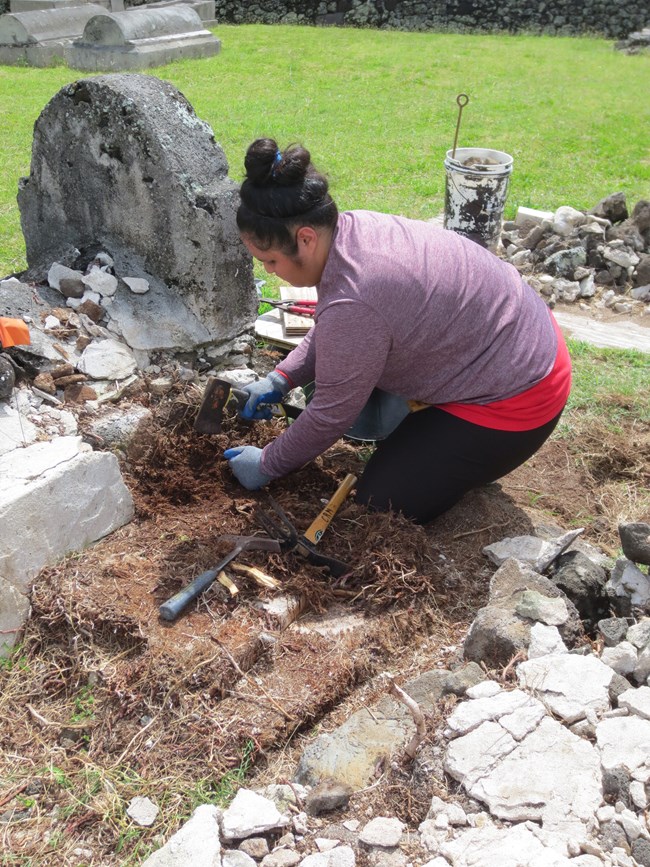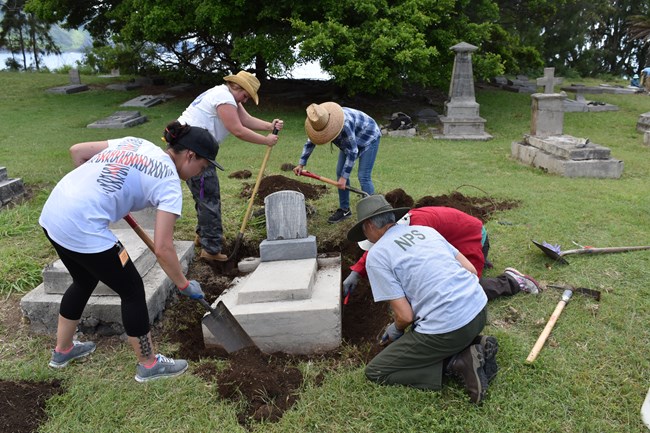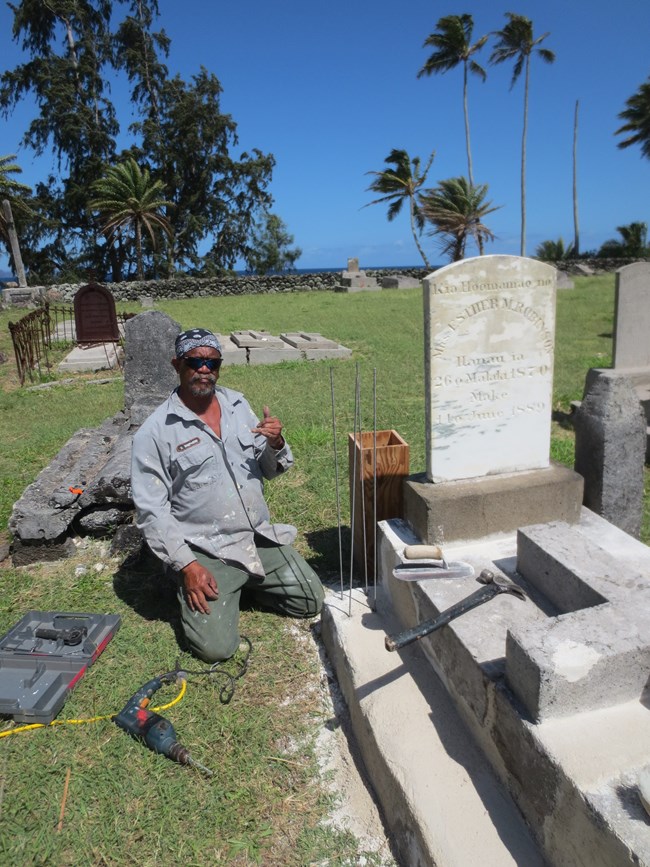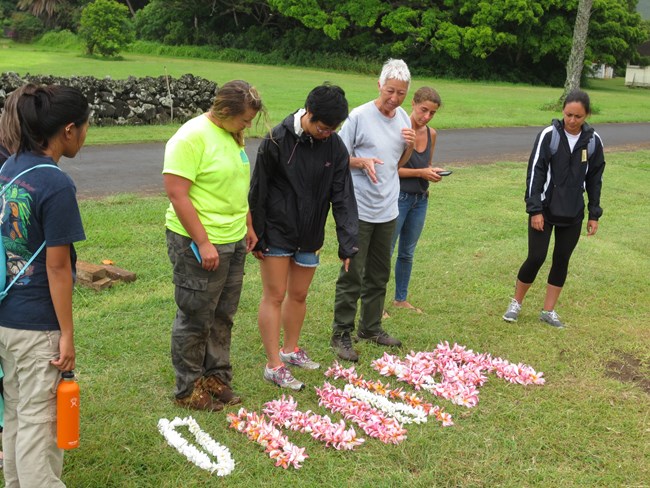Last updated: April 7, 2025
Article
Podcast 085: Cultural Protocol While Working in Hawaiian Cemeteries

National Park Service
Ask Permission from Kupuna and ‘āina
Jason Church: This is Jason Church, and I’m here on the island of Molokai, and I’m here with-
Kaile Luga: Kaile Luga.
Jason Church: What do you do here at Kalaupapa?
Kaile Luga: Currently I’m an NCPE intern with CRM here in Kalaupapa.
Jason Church: What does your job entail?
Kaile Luga: Well, we’ve been here for a few weeks, but so far I’ve been doing a lot of building assessments to update the park’s LCS assessments that need to be updated every six years. So I’m looking at historic buildings and rating what condition they’re in, and also historic monuments, and grave markers.
Jason Church: … And I’ve been here at Kalaupapa for 10 days doing a cemetery workshop. It’s been an amazing event, but one of the things that’s been very different is before every work day, and after every work day, and sometimes during the work day, we’ve been doing what you guys call protocol. Can you tell us a little bit about what that is?
Kaile Luga: Well, here in Hawai’i protocol is very important, Jason. Protocol basically mainly entails giving an oli (chant) or a mele (song), which is usually a chant, so you do that before you start work in order to ask permission to be in the area that you’re going to be in. Also to ask permission from the kupuna, or the ancestors, who have been acquainted with that area, or associated with that area, and who are resting in those areas for permission also. Not only that, but also ask the ‘āina, or the land, that we’re working on for that permission, which is very, very important.
Jason Church: I know we’ve been working in the cemeteries, so are there specific oli just for the cemetery work, or is it pretty much anytime you’re doing work with historical objects?
Kaile Luga: I would say it’s anytime you’re doing work, not only with historic objects, but just out in the land in general, because really we aren’t the first people to walk on this land. There are people who walked this land before us. Why we do protocol is to honor them.
Jason Church: At first it was something really new and exciting, and then now by the end of 10 days, when I go back to the mainland to work in cemeteries, I think I’m gonna have to keep doing it. It’s become part of the work day, definitely.
Kaile Luga: Awesome.

National Park Service
Singing Oli
Jason Church: Can you give us an example of some of the oli that we’ve been singing before the workday?
Kaile Luga: One very important oli that we’ve been using is to ask permission to be in the area, also to ask for knowledge is Ē Hō Mai. It’s actually one of the more basic oli, so a lot of people here in Hawai’i are well acquainted with that oli. You would do that before going out to work, you would do that before sometimes going into a classroom. It’s a very important and simple oli, but do you want me to do it?
Jason Church: Yeah.
Kaile Luga: (chanting in Hawaiian)
So basically, you do one of those verses three times before the beginning of the work day.
Jason Church: I think one of the other important things that they kept telling us is to also, as you’re singing and listening to it, to sort of drop everything, and all negativity has to go away before we work. Which is something I can say is definitely new. I’ve not experienced that before. So that was an important part, I think it lightened the whole day, it made everything go better.
Kaile Luga: Yep. Definitely. Something here in Hawai’i is you don’t namunamu, mai namunamu, don’t grumble, especially when you’re doing work in wahi kūpuna, so places associated with ancestors and people who have lived here before us, or just doing work in general. When you’re farming, mai namunamu or else the kalo [taro; a main staple of the Hawaiian diet] is gonna turn out bad.
Jason Church: Give us an example of one of the oli that we did at the end of the work day.
Kaile Luga: Okay, so at the end of the work day the oli that we mostly use is He Mū, and He Mū is actually kind of an older oli. If I can recall correctly. I’m pretty sure it’s in Hawaiian Antiquities, which was written by David Malo and later translated by Emerson. This oli, I’m sure it was used throughout time until today, but for a while it was kind of lost, and a lot of oli weren’t really practiced until a group of Hawaiian practitioners came together, and they decided they were going to revitalize oli, and have protocol be a part of everyday work.
So the Kanaheles went and they found this oli, and they kind of put it out there for everybody. And so this oli that we use at the end of the work day is He Mū. It’s basically cutting off any thing you may have taken with you during the work day. We’re gonna kind of enter the more spiritual realm right now, but you know working out in the cemetery there are good spirits and bad spirits, and working anywhere there are good spirits and bad spirits, but really you just want to leave everything that you took with you there. You don’t want to take it with you, at least that’s what I was taught. That’s the mana’o (thinking or thought) that was taught to me.
Jason Church: Yeah. I know that we did He Mū this morning before a lot of people flew out, because they wanted to make sure that they left any spirits on the island, here on Molokai.
Kaile Luga: Yeah. And it’s not scary stuff, it’s not just scary stuff. You also don’t want to be affecting the place itself either with your energy, so just to drop, cut everything. That’s at least what I was taught. You gonna back me up with He Mū?
Jason Church: All right, I’ll try.
Kaile Luga and Jason Church: (chanting in Hawaiian)

National Park Service
Examples of Oli
Kaile Luga: And so noa is basically like everything is free, and honua is the earth. At the end of the day, everything is free. Free from haumia, which is defilement.
Jason Church: Are there any others, other than the two standard ones we’ve been doing? Any other ones that we should know about?
Kaile Luga: Any other chants? It all just depends on what place you’re at, Jason, but something that I wish we could’ve got on videotape or something was we took a huaka’i or a field trip out to Kalawao, and people were just … especially the kids from UH-Hilo. Man, they were just inspired to pull out their oli, and their hula (dance), and it was beautiful.
Jason Church: Now, what’s the one you guys tried to teach us that none of us could learn?
Kaile Luga: The one that we tried to teach at the end actually is a pule that was taught to me. So a pule is like a … it’s a chant still, but pule is usually translated more like prayer. It’s a pule that was taught to me while I was doing work on Hawai’i Island, over in, and we were working in the ‘ohana (family) cemetery, and we were working around a lot of unmarked grave markers out in the field, also when we were doing our surveys. This pule is called Pule Ola Lō’ihi which is like a prayer for long life. But yeah, it’s asking to have a long life, and usually we would do it after we were done working, just to also … working around grave markers and cemeteries is such a deep … pretty serious, it’s a pretty serious place.
Jason Church: Definitely.
Kaile Luga: Just to remind yourself that life is precious, we all want to live long and happy lives. So this pule, it’s asking for a long life, and I can do it for you I guess?
Jason Church: Yeah. Let’s hear it.
Kaile Luga: (chanting in Hawaiian)
So basically in this Pule you’re asking for a very, very long life, until your eyes are squinty like the `iole, the rat, and until your skin is like the hala (pandanus leaves or tree), so all worn.

National Park Service
Jason Church: And even when we were working out there, so we sang before, we sang after, but we would also … and I’ve always done this even before we were here working in Hawai’i, was if we have to step on a grave or climb on a grave, we also sort of ask forgiveness, and apologies to those that we may have bothered. Thank you very much.
Kaile Luga: No problem. Thanks, Jason.
Ethnography
Jason Church: I’m here with-
Ka`ohulani McGuire: Ka`ohulani McGuire, I’m the cultural anthropologist at the park.
Jason Church: So, what do you do out here, Ka`ohulani?
Ka`ohulani McGuire: My main job is ethnography, and oral history work. I’m kind of like the park liaison between the patients and the park. Besides that I also help with cultural protocol. Before I came to the park, cultural protocol wasn’t really done much, so it’s something that I felt was important to do, try to incorporate Hawaiian culture into everything that we can.
Jason Church: During our cemetery workshop, we’ve done songs and chants and oli, between work and end of day. Besides the ones we’ve done out here in the cemetery, what other kind of protocols do you have?
Ka`ohulani McGuire: We do protocol for different reasons, but basically the main reason we do protocol is to pay respect to the place where we’re at. Like say if our work crew is gonna be working at the crater, and it’s the first time they’re going there to start a new project, we always do things at the beginning of a project, and we always have a closing at the end. So, we would do protocol there, and it would be asking for a similar thing, we do E Ho Mai, a lot, asking for a blessing, asking for the knowledge of that place to be revealed to us, and we’re also asking for knowledge that necessarily is not really visible, but knowledge from the unseen, and the spirit world as well, and from our ancestors, our kūpuna. We do protocol in relation to, for example, we found recently an inadvertent burial, and so when we did the reburial, we did protocol for that, and it’s different chants and different culture protocol in relation to burials and working with iwi (bones of the deceased).
I’ve also done repatriation work. Not with the park, but with … before I came to the park. There’s definitely protocols and chants specifically done in that kind of work.
Jason Church: You mentioned that you are liaison between the park and the patients. Can you tell us a little bit about that?
Ka`ohulani McGuire: I’ve been coming to the park for about 17 years now, and I actually have been working for the park service for the last 7 years. Because I had a relative that was a patient here, I was able to early on establish a really good relationship with the patients, because I had family here. Even after my ethnographic study was done I continued to come back to the park, I maintained those relationships, and so when the park was getting ready to hire an anthropologist, they asked me to come on board because Kalaupapa is really sort of like a closed community, for the most part. It’s a lot more open now than it used to be, but it was … it used to be much harder for outsiders to come in and break in to the community, and to gain their trust. Because I already had that establishment with the patients, and close ties with them, it’s worked out really well.
I do a lot of oral history work, not so much formal oral history any more, more informal talk story. I spend a lot of time with them, I do consultation on park projects, find out what they think about the work that we do, and how we could improve it, their vision for the future of the park after they’re gone.
Jason Church: So, what do they think about all the cemetery work we’re doing?

National Park Service
Consultation
Ka`ohulani McGuire: Well, I’m currently doing consultation with them right now. For the most part, they’re happy with it. They really are because they remember times when the cemetery was overgrown, when it wasn’t taken care of. Like Kahaloko Cemetery out in the middle of the peninsula, they remember when you couldn’t even see it from the road. It was just all trees and bushes. When they first came in ’42, the patients, the last bunch of big patients that came in ’42, they didn’t know it was a cemetery. They couldn’t tell from looking from the outside in. They are very happy.
Jason Church: How many cemetery sites are on the peninsula?
Ka`ohulani McGuire: That’s an interesting question. We talk about that quite a bit because at Papaloa there’s 11 sites, but in my view, it’s really all one big cemetery.
Jason Church: Sure. It definitely looks like [it] with the occasional wall between them.
Ka`ohulani McGuire: Yeah. It’s just that they divided it up by religion. Really religion and not really ethnicity. Because the Chinese and the Japanese have their own Buddhist beliefs, it’s really by religion than ethnicity. There is the one in Makanalua 00:01:14] across from the crater, Kahaloko. There is the ones at Kalawao by St. Philomena church. Yeah, there’s several there. And then throughout the peninsula there’s unmarked burials here and there that we’ve found.
Jason Church: Because all these burials are just since it was an established …
Ka`ohulani McGuire: 1866, yeah.
Jason Church: Yeah, so there were definitely burials before that.
Ka`ohulani McGuire: Right.
Jason Church: So do you want to mention just briefly what Kalaupapa is and why there are patients here, that sort of thing?
Ka`ohulani McGuire: Yeah. Kalaupapa was a former leprosy colony. Now we refer, the State has actually adopted the term “Hanson’s Disease” instead of leprosy. So in 1866, patients were sent here as a matter of segregation by the Hawaiian kingdom and I really feel like the king really had his hands tied in a way. He wasn’t sure how best to deal with the problem. And he was under a lot of pressure by foreigners that were afraid of the disease and wanting to segregate people. And Kalaupapa is basically a natural prison because it’s got water on three sides and almost a 2,000 foot cliff on one side.
So it seemed like a logical solution at the time. So, since 1866 people have been sent here against their will, separated from their families. It caused a lot of heartache and pain for Hawaiian families and it is no longer a leprosy, active colony, since 1969 the segregation law was lifted and patients are free to travel wherever they want and to come and go as they please. But for them, this place is their home. This is what they know, they were sent here, many of them as children or young adults and this is where they feel the most comfortable.
Jason Church: Now we talked about, yeah everything I had read before I came here talked about the heartache, but it’s amazing how everyone pulled together to make such a community here. I mean we’ve only been here two weeks and it’s amazing how many people I’ve met and how many people have hugged me and the handshakes. I don’t think I’ve ever been hugged as much in my entire life by people I just met as here.

National Park Service
Visiting Kalaupapa
Ka`ohulani McGuire: That’s Hawaiian culture, generally.
Jason Church: Yeah, it’s a very open place and a very welcoming place, I feel.
Ka`ohulani McGuire: You know, for the patients, I would say 20, 30 years ago they weren’t so used to having people touch them. One of the nurses that used to be here, she’s retired now, she tells a story how one patient would come in at 5:00 every morning to the care home and she wasn’t sure how he would react if she gave him a hug and a kiss. And she just started doing that and he finally got used to it and every day he would come and say, “Where’s my hug?” And I find, yeah, patients are a lot more open now to visitors and to touching and that kind of thing. In the past it wasn’t like that.
One story I can tell is the nurse’s quarters, it used to be separated, it still has a picket fence now, but that was a separation line. All the administration staff lived on one side of the fence and the patients couldn’t enter beyond that white picket fence. And so this was … happened in the 1990’s and some friends of mine were here visiting and they invited a patient over for dinner and they were staying, visiting someone that lived at the nurse’s quarters. And so they were waiting for him to show up and it was 20 minutes past the time they had agreed on for dinner and they were getting worried. So they went out to go look for him and they went out to the sidewalk and there he was on one side of the picket fence, standing there crying because he couldn’t make himself cross over that line. Because it had been so ingrained into him that he couldn’t cross that line because of the separation.
So they took his arm on each side and they all walked across the line together.
Jason Church: So if people do want to come to Kalaupapa to visit, people from the outside, there are tours here. How would one come to Kalaupapa?
Ka`ohulani McGuire: So we have a tour, we have Damien tours and you can fly in. We also have the mule skinners from topside Molokai and you can ride the mule down or you can hike in. And that’s just for day tours. If you want to stay overnight, you really have to know someone in the settlement that’s a resident, a patient, or an employee that works here and they can sponsor you in — six visitors at a time.
Jason Church: So there are tours available from Damien Tours to come visit?
Ka`ohulani McGuire: Yes and it runs six days a week, Monday through Saturday. One of the things that people tell me a lot and it always amazes me when visitors tell me this, even if they’re only here for the day. They all seem to tap into the feeling of the land and the ‘āina and many of them have told me they feel that this is such a powerful, sacred place. And many people also at the same time feel a lot of heaviness and sadness. Especially out at Kalawao.
Jason Church: Yeah, there definitely is different feelings, depending on where you’re moving around on the peninsula. There definitely is a different vibe in different areas of the peninsula.
Well, thank you Ka`ohulani for talking with us.
Ka`ohulani McGuire: Nice having you guys here, we loved it. Thank you.
Read other Preservation Technology Podcast articles or learn more about the National Center for Preservation Technology and Training.
